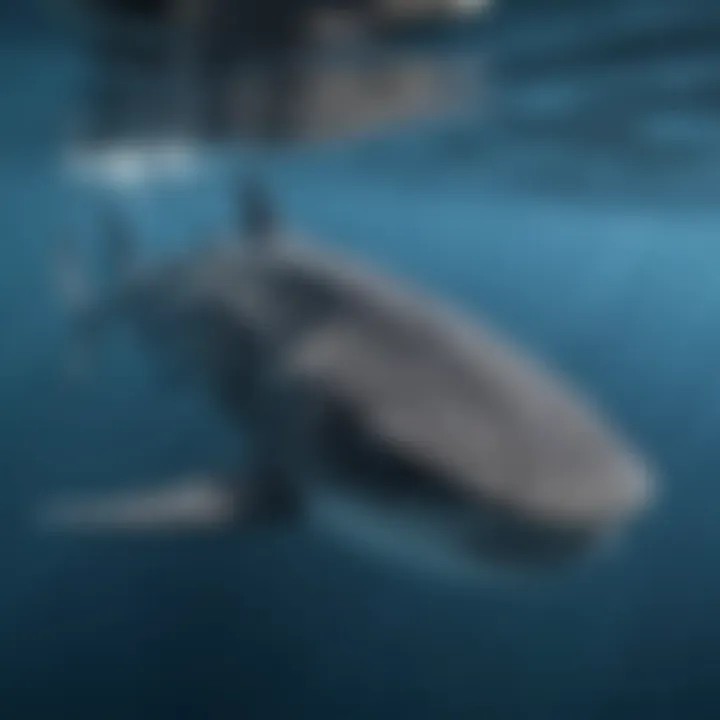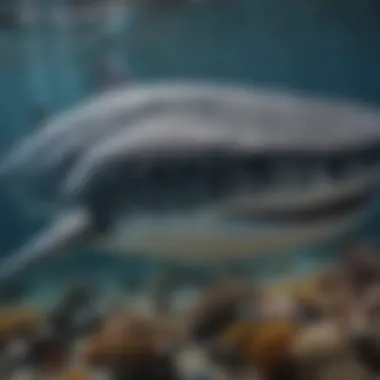Exploring the World of the Whale Shark: Nature’s Gentle Giant


Nature Topic Overview
Whale sharks are the largest fish found in the oceans. These gentle giants can grow up to 40 feet long, but their size is not what makes them fascinating. Unlike most sharks, whale sharks are filter feeders, eating mainly plankton. This means they swim with their mouths open, filtering tiny organisms from the water. The whale shark is not only remarkable for its size but also for its calm demeanor, often allowing swimmers and divers to share the water with them.
Understanding these unique creatures is essential, as they play a significant role in marine ecosystems. Their presence indicates a healthy ocean environment. However, they are currently facing threats from human activities such as fishing, pollution, and boat traffic. Protecting the whale shark is vital for preserving biodiversity in our oceans and ensuring that these majestic animals continue to thrive for generations.
Fun Facts and Trivia
Here are a few interesting facts about whale sharks that young readers will find captivating:
- Largest Fish: Whale sharks can weigh up to 20 tons.
- Eating Habits: They can consume up to 2,000 pounds of plankton in one day.
- Longevity: These sharks can live for over 70 years.
- Unique Patterns: Each whale shark has a unique pattern of spots, similar to fingerprints in humans.
To engage young learners, visuals of whale sharks can be included. This can range from images of the sharks swimming in coral reefs to diagrams explaining their feeding process.
Wildlife Explorations
In addition to whale sharks, many other creatures inhabit the same waters. For example, manta rays, sea turtles, and various species of fish can often be seen in the same locations. Some interesting facts about these animals include:
- Manta Rays: Manta rays can have wingspans of up to 29 feet.
- Sea Turtles: There are seven species of sea turtles, all of which are endangered.
- Coral Reefs: These ecosystems provide shelter for over a quarter of all marine life.
Interactive features such as quizzes about the different species or puzzles where children match animals with their habitats can enhance learning and engagement.
Environmental Awareness
Conservation efforts are critical for the survival of whale sharks and other marine life. Here are some important aspects of conservation:
- Threats to Whale Sharks: Overfishing, pollution, and habitat degradation endanger these gentle giants.
- Sustainable Practices: Promote sustainable fishing and responsible tourism to minimize impact on marine life.
Children can help protect nature by:
- Reducing plastic use, which often ends up in the oceans.
- Participating in beach cleanups.
- Educating others about the importance of marine conservation.
DIY Nature Activities
Hands-on activities can deepen children’s connection to nature. Here are some ideas:
- Create a Whale Shark Mask: Use paper plates and decorate them like whale sharks.
- Nature Journals: Encourage kids to observe local waterways and write about what they see in a journal.
- Outdoor Exploration: Organize trips to aquariums or local beaches to observe marine life firsthand.
These activities can help foster a sense of responsibility towards nature and promote a love for marine life.
"The whale shark is not only a gentle giant but also a crucial part of our ocean's health."
By understanding the marvelous whale shark and its environment, we can make informed choices to protect it. Learning about these creatures inspires a commitment to ocean conservation.
Whale Shark Overview
The whale shark holds an esteemed position in marine biology. As the world's largest fish, it captures interest for its unique size, behavior, and ecological role. Understanding the whale shark is crucial for education about ocean health and conservation needs. This section will delve into fundamental aspects of this species, setting the foundation for further discussion throughout the article.
Taxonomy and Classification
The whale shark is scientifically known as Rhincodon typus. It belongs to the family Rhincodontidae, a group of carpet sharks. The classification system for whale sharks emphasizes their distinct characteristics compared to other species. Whale sharks are categorized under the class Chondrichthyes, which includes all cartilaginous fish. This classification highlights their unique evolutionary path within the oceanic ecosystem and provides insight into their biological characteristics and behavior.
Physical Characteristics
Size and Weight
Whale sharks are remarkable for their immense size. They can reach lengths of up to 40 feet or more and weigh as much as 20 tons. This size makes them the largest fish in the ocean. The size of the whale shark is not only impressive but also plays an important role in their feeding strategies. A larger size allows them to swim through different water layers to access a wide range of food sources, contributing to their sustainability.
Coloration and Patterns
The skin of the whale shark is covered in a distinctive pattern of white spots and stripes against a dark blue or gray background. This unique coloration serves two primary purposes. Firstly, it provides camouflage against predators and, more importantly, aids in their identification among individual sharks. Each whale shark has a unique pattern, similar to human fingerprints, which is beneficial for researchers aiming to study their behavior and population dynamics.
Body Structure
The body structure of the whale shark is designed for its filter-feeding lifestyle. Its broad, flat head houses a large mouth that can open up to five feet wide. The mouth's structure is adapted to filter small prey from the water. Whale sharks possess gill rakers that trap food particles, allowing water to flow through and exit while capturing nutrients. Understanding their body structure is essential for comprehending how these creatures successfully navigate and thrive in their marine environments.
Habitat of the Whale Shark


Understanding the habitat of the whale shark is vital for grasping their behavior and survival. Their habitats define where they thrive, locate food and reproduce. Whale sharks inhabit specific ocean regions that provide the essential conditions for their existence. A thorough exploration of their habitat enhances our appreciation of these majestic creatures and underscores the significance of protecting their environments.
Geographical Distribution
Tropical and Warm Waters
Tropical and warm waters are the primary habitats for whale sharks. These environments are typically found near the equator, where temperatures range from 21°C to 28°C. The abundance of plankton in these waters makes them a perfect feeding ground for whale sharks. The warm currents also attract a variety of small fish, which contributes to the health of the ecosystem.
One of the key characteristics of tropical waters is their relatively stable temperature, which allows the whale sharks to maintain their body temperature more easily.
However, these waters can be susceptible to pollution and climate change. Increased sea temperatures can disrupt feeding patterns and migrations of whale sharks, making it essential to monitor and maintain the health of oceanic environments.
Migration Patterns
Migration patterns of whale sharks are a fascinating aspect of their life cycle. These sharks are known to travel thousands of kilometers, following seasonal patterns driven mainly by food availability and breeding. They often move from areas of high phytoplankton concentration to other regions, such as coastal areas during certain times of the year.
The key characteristic of these patterns is their timing. Many whale sharks synchronize their movements with the seasonal blooms of plankton, ensuring access to abundant food supplies. This characteristic is significant for understanding their feeding habits and movement behavior.
A unique feature of the migration patterns is the variability in their routes. Each population of whale sharks may have different routes, which are influenced by local environmental conditions. This variability also presents challenges for conservation efforts, as it complicates tracking and protecting these migratory paths.
Preferred Environments
Coastal Areas
Coastal areas serve as important habitats for whale sharks, especially during their mating season. These regions are typically rich in nutrients and provide ample food resources. Whale sharks can often be found near coral reefs and coastal lagoons, where their presence supports the local ecosystem.
The unique feature of coastal environments is their diversity. These areas can support a wide variety of marine life, which in turn attracts sharks. Coastal regions also provide a breeding ground for many species, including small fish that are prey for larger fish like whale sharks.
While coastal areas are rich in life, they face threats from pollution, overfishing, and coastal development. These factors can disrupt the delicate balance of the ecosystem and put whale sharks at risk.
Open Ocean
The open ocean represents another essential habitat for whale sharks. This vast space is where they often feed on scattered plankton and small fish. The open ocean allows for deep diving and exploration of deeper waters, which can host more concentrated food sources.
One key characteristic of open ocean environments is their unpredictability. Whale sharks can encounter vast areas with variable food availability. This makes them adept at navigating through changing conditions.
However, the open ocean also poses risks. Human activities such as fishing, shipping, and pollution affect this environment. As whale sharks migrate through these waters, they may encounter dangers that jeopardize their survival.
In summary, whale sharks thrive in diverse habitats, including tropical waters and coastal areas. Their migration patterns reflect their adaptability to environmental changes. Understanding these aspects is crucial as we aim to protect these gentle giants and their intricate habitats.
Behavior and Feeding Habits
Understanding the behavior and feeding habits of whale sharks is crucial in appreciating their role in marine ecosystems. These aspects help to explain how they survive in their environments and interact with other species. It also sheds light on their significance in the oceanic food web. Whale sharks exhibit unique feeding mechanisms and social dynamics, making them fascinating subjects for study and conservation efforts.
Feeding Mechanisms
Filter Feeding
Whale sharks are known for their distinctive filter feeding method. This technique involves swimming with their mouths wide open, allowing water to flow in. They then use their gill rakers to filter out plankton and small fish, which are their primary food sources. This way of feeding is environmentally beneficial. It focuses on smaller organisms, helping to maintain balance in the marine food web. One key characteristic of filter feeding is its efficiency. The whale shark can consume large quantities of food while expending minimal energy.
While this method is advantageous, it is not without its challenges. The quality of the water and the density of available prey can impact feeding success. Changes in ocean conditions can lead to competition for resources among these gentle giants.
Preferred Prey Species
The preferred prey species of whale sharks include zooplankton, small fish, and sometimes even jellyfish. These selections are significant for several reasons. Firstly, they highlight the whale shark’s adaptability to various environments. Secondly, understanding these prey species allows for better assessments of the health of marine ecosystems. A unique feature of their feeding behavior is that whale sharks can often be seen aggregating in areas where plankton is abundant. This can be a feeding frenzy, attracting other marine life. The presence of diverse prey species fosters a healthy environment, providing sustenance not only for whale sharks but also for other ocean inhabitants. However, fluctuations in the abundance of these species can influence the survival of whale sharks, making it a vital consideration in conservation strategies.
Social Behavior
Solitary vs. Social Living
Whale sharks display both solitary and social living patterns. Most often, they are solitary creatures. They tend to roam vast ocean areas alone, likely in search of food and suitable habitats. However, during certain times of the year, especially at feeding hotspots, they can be found gathering in groups. This social behavior contributes to increased feeding opportunities. The adaptability of whale sharks to switch between solitary and social living is noteworthy. It indicates their ability to thrive in changing ocean conditions. Nonetheless, being solitary may also pose risks, such as increased vulnerability to threats.
Interactions with Other Marine Species
Interactions with other marine species are essential to whale sharks. These gentle giants often share their feeding grounds with various fish, making their role in the ecosystem even more significant. These interactions highlight the interconnectedness of different marine species. Noteworthy is the behavior where smaller fish often accompany whale sharks for protection and easy access to food. This relationship benefits both parties, as the small fish get safety while the whale shark clears the water of plankton. Such interactions may also influence conservation efforts. Understanding these relationships helps in crafting effective strategies. The decline in whale shark populations could disrupt these dynamics, affecting other marine life in the process.
"The whale shark’s behavior and feeding habits are vital in understanding their ecological role and the implications of their conservation."
In summary, the examination of whale sharks’ feeding mechanisms and social behaviors provides insights into their ecological significance, survival strategies, and the challenges they face in an ever-changing ocean.
Reproduction and Lifespan


Understanding the reproduction and lifespan of the whale shark is key to grasping its role in the ocean's ecosystem and the future of its populations. These aspects are vital for scientists and conservationists. By learning about how whale sharks reproduce and how long they live, we can better protect them and ensure they thrive for generations.
Reproductive Strategies
Gestation Period
The gestation period of whale sharks is a somewhat mysterious topic. Studies suggest it can last around 10 to 12 months. This length of time allows the developing embryos to grow in a safe environment. A longer gestation can be beneficial because it gives the embryos sufficient time to develop into viable pups.
One unique feature of whale sharks is that they are ovoviviparous. This means that the eggs develop inside the female, and live young are born instead of laying eggs externally. This strategy potentially increases the survival rate of the offspring, as they are born into suitable conditions with parental protection.
However, more research is needed to understand the full implications of the whale sharks' gestation period. The challenges they face during gestation can include environmental threats, making it crucial to monitor their health closely.
Offspring Development
After birth, whale shark pups are about 60 to 70 centimeters long. Their initial size ensures they have a good chance of survival in their early life stages. As they grow, their diet shifts and their behaviors adapt to different environments.
Whale shark pups tend to live in shallow, protected waters to gain nourishment and avoid predators. This habitat choice benefits young sharks by providing an abundance of food, mainly small plankton and crustaceans. However, this reliance on certain environments can expose them to human activities like fishing or pollution, which can have negative effects on their development.
Lifespan
Average Lifespan
The average lifespan of whale sharks is estimated to be between 70 and 100 years. This longevity is impressive and contributes to the stability of marine ecosystems. Older individuals might help maintain balance in their habitats by their roles in the food web.
A benefit of a longer lifespan is that females can reproduce multiple times throughout their life, increasing the chance for the species to maintain healthy population levels. However, a lengthy lifespan also means that individual whale sharks are potentially at risk from threats posed by humans, such as fishing and habitat destruction.
Factors Influencing Longevity
Several factors can affect the lifespan of whale sharks. Environmental conditions, food availability, and threats like fishing are significant influences. Healthy habitats can support longer-lived sharks, while adverse conditions lead to shorter lifespans.
A key factor influencing longevity is the genetic health of the shark population. A genetically diverse population is more resilient to diseases and environmental changes. However, human activities often threaten genetic diversity, making it vital to protect these gentle giants as a whole.
Overall, understanding the reproductive strategies and lifespan of whale sharks allows for informed conservation efforts to help ensure their future in our oceans. The knowledge gained not only aids scientists but also fosters awareness among the public about the importance of preserving such magnificent creatures.
Ecological Role
The ecological role of the whale shark is fundamental to marine ecosystems. As the largest fish in the ocean, these gentle giants serve various critical functions that support both sea life and human interactions with the ocean.
Importance to Marine Ecosystems
Impact on Food Webs
The whale shark plays a significant role in maintaining the balance of marine food webs. They are filter feeders, primarily consuming tiny plankton, krill, and small fish. By doing so, they help regulate populations of these organisms, which is essential for the health of their ecosystems. The presence of whale sharks can indicate a healthy environment, as their feeding habits contribute to nutrient recycling in the water.
The key characteristic of their feeding approach is its selective nature. This allows them to sustain their size while ensuring a diverse population of smaller marine life. A beneficial aspect of their role in the food web is their ability to clean the ocean of excess plankton, preventing blooms that can disrupt local ecosystems. However, their dependence on specific prey may pose a risk if these populations dwindle due to environmental changes.
Contribution to Biodiversity
Whale sharks contribute significantly to marine biodiversity. They are part of a complex ecosystem where their presence can foster a habitat for other marine species. For example, their large size can provide shelter for various smaller fish and marine organisms, creating a micro-ecosystem around them. This characteristic enhances local biodiversity and promotes a more resilient marine environment.
While whale sharks primarily impact biodiversity through their influence on prey species, their movements across various habitats also facilitate gene flow among different fish populations. This genetic interaction is crucial for the overall health of marine ecosystems. However, changes in their populations due to threats can result in a decline in biodiversity, highlighting their importance.
Interaction with Humans
Ecotourism
Ecotourism centered around whale sharks has grown in popularity. This aspect provides economic benefits to local communities while promoting conservation efforts. In regions where whale sharks are present, tourism can create incentives for protection and preservation of marine environments. Tourists flock to see these magnificent creatures, which raises awareness and funds for conservation.
The key feature of ecotourism related to whale sharks is the educational value it brings. Visitors learn about marine ecosystems and the importance of conservation. However, careful management of ecotourism is essential to prevent disturbances to their natural behavior and habitat.
Research Contributions
Research on whale sharks contributes immensely to marine science. It helps scientists understand their migration patterns, reproductive strategies, and the overall health of marine ecosystems. This information is vital for effective conservation strategies. Knowledge gained from studies can also inform policymakers about the necessary actions needed to protect these creatures and their habitats.
The unique feature of ongoing research is the use of technology for tracking and studying whale sharks. Advancements in satellite tracking and underwater monitoring provide insights that were previously unattainable. Despite the advantages of these methods, challenges exist concerning data accessibility and the potential impact of human interference in research settings.
Conservation and Threats


The conservation and threats surrounding the whale shark is a crucial topic within marine biology and environmental studies. This gentle giant faces multiple challenges that endanger its existence. Understanding these threats and the ongoing conservation efforts is essential for ensuring the whale shark's survival. Conservation not only protects whale sharks, but it also preserves the intricate balance of marine ecosystems they inhabit. By addressing threats, we can enhance ecological stability, maintaining biodiversity and supporting other marine life.
Conservation Status
IUCN Red List Classification
The International Union for Conservation of Nature (IUCN) Red List is a key resource that categorizes species based on their risk of extinction. The whale shark is classified as "Vulnerable" on this list. This designation highlights the need for proactive measures to safeguard this species. It serves to raise awareness about the whale shark's struggles, emphasizing the importance of conservation efforts.
The key characteristic of the IUCN Red List is its rigorous evaluation process, which assesses various factors like population trends and threats. This classification is beneficial as it brings attention to species like the whale shark that might otherwise go unnoticed.
A unique feature of the IUCN classification is its global recognition, which encourages coordinated conservation actions across countries. However, the disadvantages include that it may not always lead to immediate protective measures. For the whale shark, more awareness and initiatives are essential to transition from classification to meaningful protection.
Legal Protections
Legal protections are crucial for the survival of the whale shark. Many countries have laws in place that ban or strictly regulate whale shark fishing. Such protections aim to reduce the threat of extinction by safeguarding vulnerable species. Key characteristics of these laws include fines for illegal fishing and restrictions in critical habitats.
These legal protections are beneficial as they help create safe environments for whale sharks. They enable the population to recover over time, if enforced effectively. The unique feature of these protections is that they often require international cooperation, given that whale sharks migrate across oceanic boundaries.
However, enforcing these legal frameworks can be challenging. Some countries might lack the resources to monitor compliance. Therefore, ongoing support and collaboration between governments, NGOs, and communities are vital to ensure the success of these legal measures.
Threats to Survival
Fishing and Bycatch
Fishing and bycatch present significant threats to whale sharks. Bycatch refers to the capture of unintended species during commercial fishing. Whale sharks can become entangled in nets or caught on hooks, leading to injuries or death. The key characteristic of fishing practices today is that they often prioritize profit over marine life welfare. This creates an urgent need for better practices and technology.
Fishing and bycatch is a popular topic in conservation discussions because addressing it could significantly reduce unnecessary whale shark deaths. The unique aspect of this issue is that it requires a shift in the fishing industry, promoting sustainable practices. The challenge lies in balancing economic interests with environmental needs.
Habitat Loss
Habitat loss also remains a critical threat to whale sharks. Coastal development and pollution degrade the environments in which these creatures thrive. The destruction of coral reefs and mangroves affects the availability of food resources and breeding grounds for whale sharks. The key characteristic of habitat loss is its widespread impact on marine ecosystems.
Habitat loss is a beneficial focus in conservation literature because it connects the plight of whale sharks with broader ecological health. The unique feature of this threat is that it illustrates the interconnectedness of marine life; the loss of one species can have ripple effects throughout the ecosystem.
Efforts to mitigate habitat loss involve stricter regulations on coastal development and pollution controls. However, achieving these objectives requires widespread awareness and commitment from local communities and policymakers alike.
Future Directions for Whale Shark Research
Understanding the future directions for whale shark research is crucial for the conservation and effective management of this species. As we explore new areas in research, we aim to address gaps in knowledge that can lead to better protection efforts. Increased understanding of their genetics and population dynamics also helps in assessing how climate change and human activities affect their survival. Furthermore, supporting community involvement enhances conservation strategies. These areas of focus will not only benefit whale sharks but also help in sustaining marine ecosystems.
Emerging Research Areas
Genetics and Population Studies
Genetics and population studies provide deep insights into the whale shark's genetic diversity and population structure. This research is essential for understanding how individuals are related and how populations are distributed across their habitats. By analyzing genetic material, researchers can identify unique populations that may require targeted conservation efforts. This aspect is a beneficial choice for discussions here because it highlights how genetic health influences overall population resilience. The unique feature of this study is that it reveals patterns in mating and breeding. However, a challenge involves the time and resources required for thorough analysis.
Technological Advances in Tracking
Technological advances in tracking whale sharks have revolutionized our ability to study their behaviors and migratory patterns. GPS and satellite technology allow researchers to follow these giants as they navigate vast oceanic spaces. This aspect plays a significant role in research as it provides real-time data about their movements and habitat preferences. Notably, these tools enhance the understanding of how environmental changes affect whale shark populations. The primary advantage of using technology in tracking is that it yields comprehensive data that was difficult to obtain before. A disadvantage, though, includes potential stress on the sharks during the tagging process.
Community Involvement and Awareness
Local Conservation Efforts
Local conservation efforts are vital for protecting whale sharks at the community level. Engaging local fishermen and residents helps create a collaborative framework for conservation. By involving the community, we emphasize the shark’s importance to the ecosystem and the economy, particularly through ecotourism. This approach is beneficial as it fosters a sense of responsibility among the local population. A unique aspect is the establishment of local marine protected areas where whale shark sightings and interactions can be regulated. However, ensuring consistent engagement from the community can be challenging.
Educational Outreach Programs
Educational outreach programs focus on spreading knowledge about whale sharks and marine conservation. Such initiatives aim to enlighten children and adults alike about the role that whale sharks play in the ocean ecosystem. An important characteristic of these programs is their interactive nature, making learning engaging and informative. This makes educational outreach a popular choice for this article as it emphasizes the significance of conservation through awareness. The unique feature of these programs is that they empower participants with knowledge and responsibility towards marine life. A disadvantage can be the limit in resources available to reach wider audiences.
End
The conclusion of this article emphasizes the critical role whales sharks play in marine ecosystems and the urgency of their conservation. Whale sharks are not just magnificent creatures; they help maintain the balance of marine life. As the largest fish in the ocean, they hold a unique position within the food web, contributing to the overall health of their habitats. This significance is particularly vital given the increasing threats they face from human activities.
Summary of Key Points
- Whale sharks are the largest fish in the ocean, known for their gentle nature.
- They primarily inhabit tropical and warm waters, with specific migration patterns.
- Their feeding habits involve filter feeding on plankton and small fish, showcasing a unique adaptation.
- Reproductive strategies of whale sharks involve live births, with a relatively unknown gestation period.
- Their ecological role includes impacts on food webs and biodiversity, revealing their importance to marine life.
- Conservation efforts are crucial, given their vulnerable status due to threats like fishing and habitat loss.
- Future research is needed to explore genetic studies and community involvement in conservation efforts.
Call to Action for Conservation
It is important for everyone to play a part in whale shark conservation. Here are some steps that can be taken:
- Support Marine Protected Areas: These zones are essential for conserving habitats.
- Reduce Plastic Usage: Less plastic means cleaner oceans for all marine life.
- Participate in Eco-Tourism: Engage in sustainable tourism practices that support local communities while protecting marine species.
- Spread Awareness: Education is powerful. Share knowledge about whale sharks and their habitats with others.
- Advocate for Policies: Support initiatives that aim to protect the ocean and its inhabitants.
Whale sharks symbolize the need for a balanced ocean ecosystem. Their survival depends on our actions, and it's crucial to foster a sense of responsibility among young learners and the broader community. By understanding their habits and threats, we can better protect these gentle giants for future generations.







